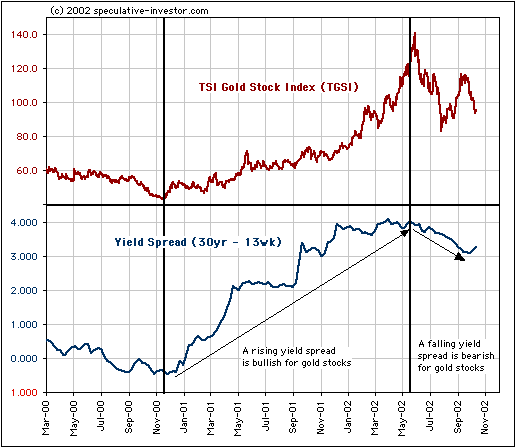
Gold Stocks
and Interest Rates
Here is an extract from commentary
that was posted at www.speculative-investor.com on 17th October 2002.
Are rising long-term interest rates
bullish for gold? The answer is "that depends". Rising long-term interest
rates are not bullish for gold unless they are rising relative to short-term
interest rates, that is, unless the yield spread is rising.
There are a lot of ways to calculate
the yield spread, but we calculate it by subtracting the yield on the 13-week
T-Bill from the yield on the 30-year T-Bond. The yields on T-Bonds, the
longest-dated treasuries, are influenced more by the market's perceptions
regarding the inflation risk than are the yields on shorter-dated treasuries.
T-Bills are the shortest-dated treasuries and have almost no inflation
risk factored into their yields. Also, whereas the market controls T-Bond
yields the yield on the 13-week T-Bill seldom wanders far from the Fed
Funds Rate target set by the Federal Reserve. In other words, the T-Bill
yield is primarily controlled by the Fed.
Further to the above, regardless of
what is happening with the absolute level of long-term interest rates the
behaviour of the yield spread often indicates whether the market is becoming
more or less worried about inflation and also whether the Fed's monetary
policy is 'tight' or 'easy'. For these reasons, the yield spread (the level
of long-term interest rates relative to the level of short-term
interest rates) plays a more important role than the absolute level
of long-term interest rates in determining whether or not the interest
rate environment is bullish for gold.
Below is a chart comparing the yield
spread and the TSI Gold Stock Index (TGSI). The up-trend in the yield spread
between November-2000 and May-2002 was accompanied by an up-trend in the
TGSI. However, since May of this year the yield spread has been trending
lower, meaning that the interest rate environment has been bearish for
gold over the past 5 months. Furthermore, regardless of what happens in
the bond market it will remain bearish unless the yield spread once again
starts to trend higher.

The downturn in the yield spread clearly
isn't the only reason that gold and gold stocks embarked on an extended
correction in May of this year. There are always a number of different
inter-market forces tugging on the gold price at any time and these forces
are seldom all tugging in the same direction. We consider the yield spread
to be one of a number of secondary forces, with the US Dollar's trend being
the only primary force. However, it will be difficult for gold and gold
stocks to experience a major rally until the interest rate environment
again turns bullish. The recent upturn in the yield spread may, in fact,
be a preliminary sign that this is starting to happen.
Over the next 6 months we think there
is a lot more upside potential in T-Bond yields (long-term interest rates)
than in T-Bill yields (short-term interest rates), for two main reasons.
First, we expect a falling US$ combined with rising commodity prices to
result in long-term interest rates moving much higher. Second, continuing
economic and financial problems, or, at least, the perception that problems
might occur, will encourage the Fed to keep short-term rates near their
current low levels. The yield spread is therefore likely to be a lot higher
in 6 months time than it is today. This is partly why we remain medium-term
bullish on gold and gold stocks.
Regular financial market forecasts
and
analyses are provided at our web site:
http://www.speculative-investor.com/new/index.html
One-month free trial available.

|

